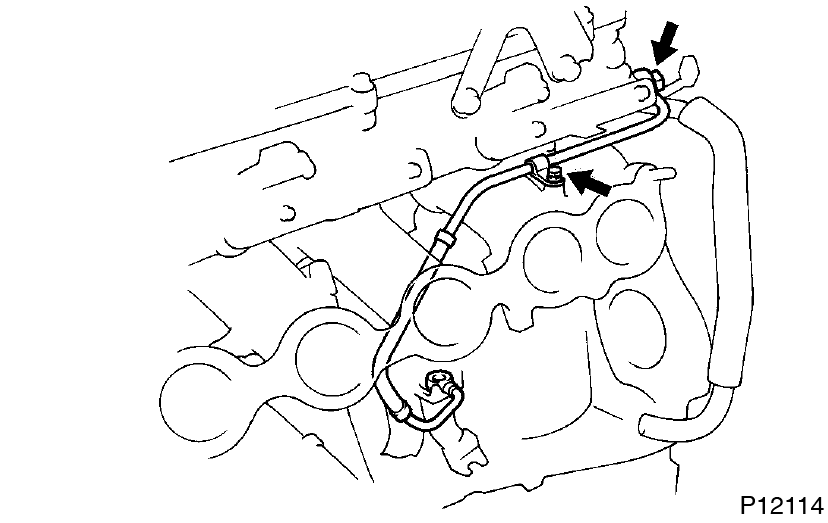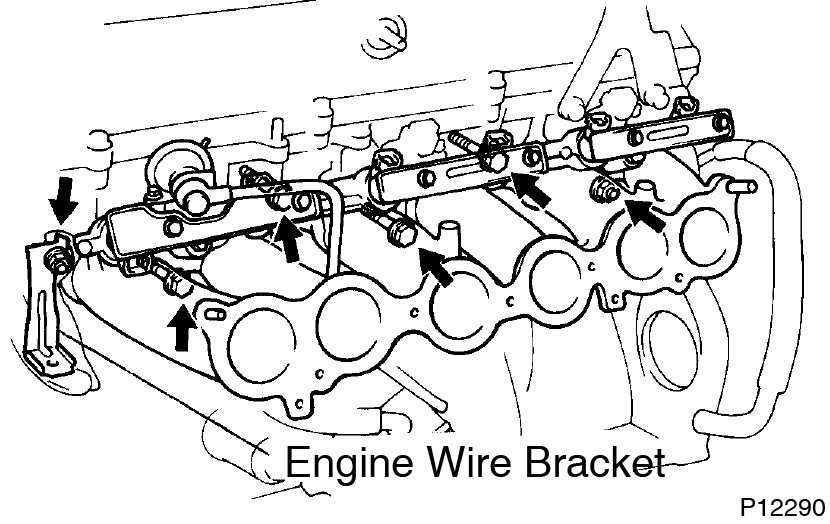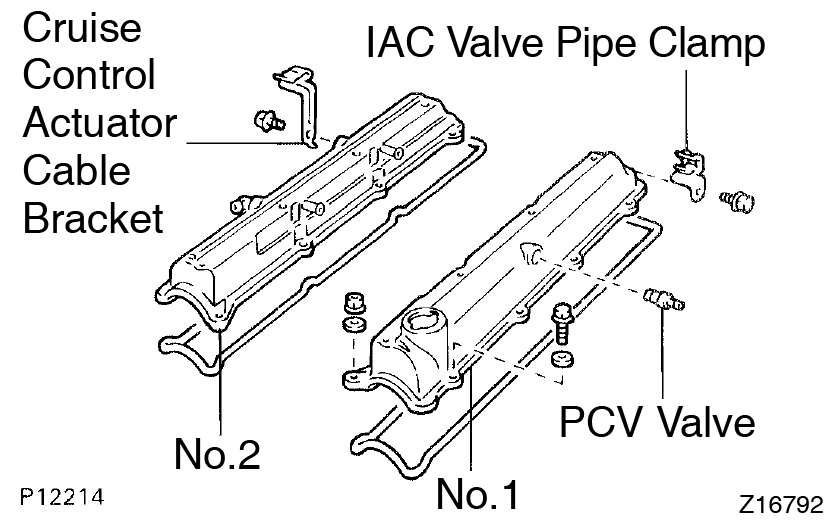- Introduction
- Maintenance
- Preparation
- Service specifications
- Diagnostics
- 2JZ-GE Engine
- 2JZ-GTE Engine
- 2JZ-GTE Turbocharging
- 2JZ-GE Emission control
- 2JZ-GTE Emission control
- 2JZ-GE SFI
- 2JZ-GTE SFI
- Cooling
- Lubrication
- Ignition system 2JZ-GE
- Ignition system 2JZ-GTE
- Starting system
- Charging system
- Clutch
- W58 manual transmission
- V160 manual transmission
- A340E 2JZ-GE automatic transmission
- A340E 2JZ-GTE automatic transmission
- Propeller shaft
- Suspension and axle
- Brake system
- Steering
- Supplemental restraint system
- Body electrical system
- Body
- Air conditioning system
- Remove turbocharger (See page TC-10 )
- Remove exhaust manifold
Remove the 12 nuts, exhaust manifold and 2 gaskets.
- M/T:
Remove drive belt tensioner damper (See page EM-15 ) - Remove drive belt
Loosen the drive belt tension by turning the drive belt tensioner clockwise, and remove the drive belt.
- Remove water outlet and No.1 water bypass pipe
- Disconnect the upper radiator hose from the water outlet.
- Disconnect the ECT sensor and sender gauge connectors.
- Remove the 2 bolts, water outlet and gasket.

- Remove the No.1 water bypass pipe and 2 O-rings.
- Disconnect PS pump without disconnecting hoses
- Disconnect these hoses:
- PS air hose from throttle body
- PS air hose from air intake chamber

- Remove the 2 bolts, and disconnect the vane pump from the pump bracket. Put aside the vane pump, and suspend it.
- Disconnect these hoses:
- Disconnect fuel return hose
Disconnect the fuel return hose from the fuel return pipe. Plug the hose end.
- Remove air intake chamber assembly (See page SF-20 )
- Disconnect engine wire

- Disconnect these connectors and clamps:
- 6 injectors connectors
- 2 camshaft position sensor connectors
- 3 engine wire clamps from injector holders
- VSV connector for EVAP

- Remove the 2 bolts, and disconnect the 2 ground straps from the intake manifold.
- Remove the nut, and disconnect the engine wire protector from the intake manifold.
- Disconnect these connectors and clamps:
- Remove pressure tank and VSV assembly
- Disconnect the 2 vacuum hoses from the pressure tank.
- Remove the 2 nuts and pressure tank and VSV assembly.

- Remove fuel pressure pulsation damper (See page SF-31 )
- Remove fuel inlet pipe
Remove the union bolt, 2 gaskets, clamp bolt and fuel inlet pipe.
- Remove intake manifold and delivery pipe assembly
Remove the 4 bolts, 2 nuts, engine wire bracket, the intake manifold, delivery pipe assembly and gasket.
- Remove timing belt from camshaft timing pulleys (See page EM-15 )

- Support the timing belt, so that the meshing of the crankshaft timing pulley and timing belt does not shift.
- Be careful not to drop anything inside the timing belt cover.
- Do not allow the timing belt to come into contact with oil, water or dust.
- Remove ignition coils assemblies (See page IG-6 )
- Remove spark plugs
- Remove No.1 and No.2 cylinder head covers

- Remove the 2 bolts, cruise control actuator cable bracket and IAC valve pipe clamp.
- Remove the PCV valve.
- Remove the 6 bolts, 2 nuts, 8 seal washers and No.1 cylinder head cover and gasket.
- Remove the 6 bolts, 2 nuts, 8 seal washers and No.2 cylinder head cover and gasket.
- Remove camshaft timing pulleys
Hold the hexagon portion of the camshaft with a wrench, and remove the pulley mounting bolt and camshaft pulley.
- Remove No.4 timing belt cover
Remove the 4 bolts and timing belt cover.
- Remove camshafts
- Uniformly loosen and remove the 4 No.1 camshaft bearing cap bolts.

- Using a screwdriver, pry out the 2 No.1 camshaft bearing caps and oil seals. Be careful not to damage the cap. Tape the screwdriver tip.

- Uniformly loosen and remove the 12 bearing cap bolts, in several passes, in the sequence shown, and remove the 6 bearing caps and camshaft.

- Remove the intake and exhaust camshafts.
- Uniformly loosen and remove the 4 No.1 camshaft bearing cap bolts.
- Remove cylinder head
- Using a 10 mm bi-hexagon wrench, uniformly loosen and remove the 14 cylinder head bolts, in several passes, in the sequence shown. Cylinder head warpage or cracking could result from removing in incorrect order.
- Remove the 14 plate washers.

- Lift the cylinder head from the dowels on the cylinder block.

- Place the head on wooden blocks on a bench.
Be careful not to damage the contact surfaces of the cylinder head and cylinder block. - Using a 10 mm bi-hexagon wrench, uniformly loosen and remove the 14 cylinder head bolts, in several passes, in the sequence shown.




